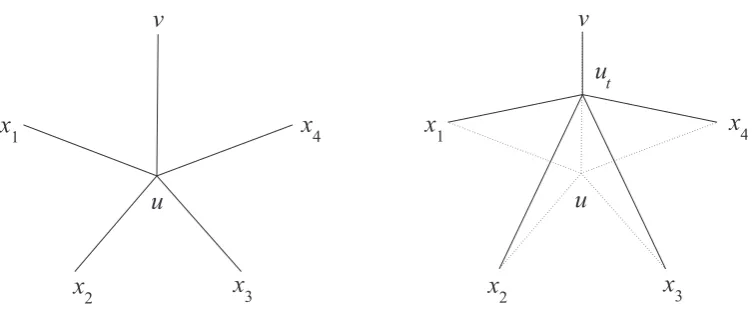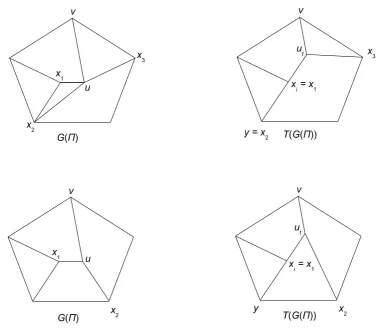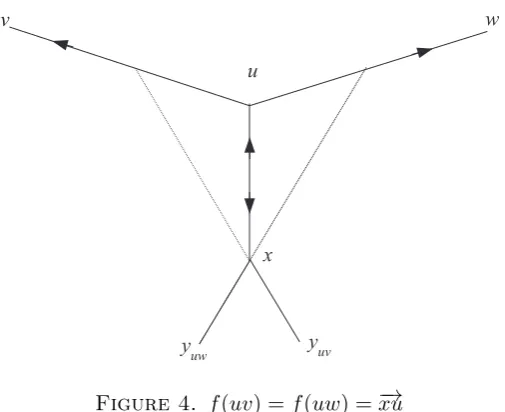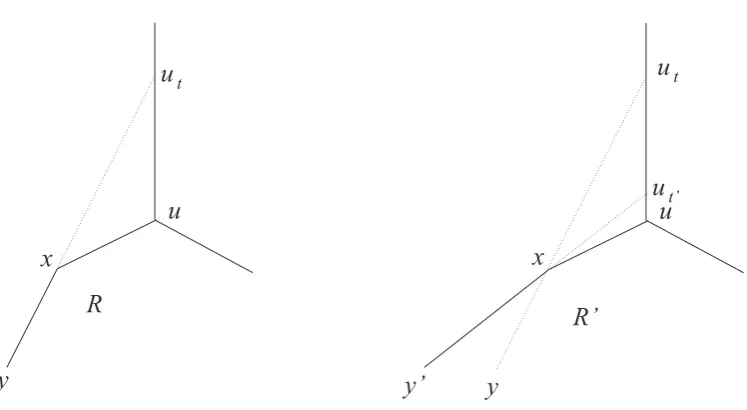1. Introduction
LetP be a set ofn≥3 points in general position in the plane. Aconvex decomposition
ofP is a set Π of convex polygons with vertices inP and pairwise disjoint interiors such that their union is the convex hullCH(P) ofP and that no point inP lies in the interior of any polygon in Π. A geometric graph with vertex set P is a graph G, drawn in the plane in such a way that every edge is a straight line segment with ends inP.
Let Π be a convex decomposition of P. We denote by G(Π) the skeleton graph of Π, that is the plane geometric graph with vertex setP in which the edges are the sides of all polygons in Π. An edgeeof Π is aninterior edge ifeis not an edge of the boundary of CH(P).
An interior edge e of Π is deletable if the geometric graph G(Π)−e, obtained from
G(Π) by deleting the edge e, is the skeleton graph of a convex decomposition of P. Neumann-Lara et al [6] proved that if a convex decomposition Π of a set P of npoints consists of more that 3n−2k
2 polygons, where kis the number of vertices ofCH(P), then Π has at least one deletable edge.
An interior edge e = uv of Π is contractible from u to v if the geometric graph
G(Π)/ ~uv = (G(Π)− {x1u, x2u, . . . , xmu, uv}) +{x1v, x2v, . . . xmv} is a skeleton graph of a convex decomposition of P\ {u}, wherex1, x2, . . . , xm are the remaining vertices of
G(Π) which are adjacent tou.
A simple convex deformation of Π is a convex decomposition Π′ obtained from Π
by moving a single point x along a straight line segment, together with all the edges incident withx, in such a way that at each stage we have a convex decomposition of the corresponding set of points. Deformations of plane graphs have been studied by several authors, both theoretically and algorithmically, see for instance [3, 4, 7] and [1, 2, 5], respectively.
Let P1 and P2 be sets of n ≥ 3 points in general position in the plane. A convex decomposition Π1 of P1 and a convex decomposition Π2 ofP2 areisomorphic if there is an isomorphism ofG(Π1) ontoG(Π2), as abstract plane graphs, such that the boundaries of CH(P1) andCH(P2) correspond to each other with the same orientation.
Ferran Hurtado worked at Universitat Polit`ecnica de Catalunya until his death in 2014. Eduardo Rivera-Campo, Universidad Aut´onoma Metropolitana-Iztapalapa,[email protected]. Partially supported by Conacyt, M´exico.
1
tool, Thomassen proved that if Π is a convex decomposition with at least two polygons, then there is an isomorphic convex decomposition Π′ that can be obtained from Π by a
finite number of simple convex deformations that preserve the boundary and such that Π′ contains either a deletable edge or a contractible edge. In this note we prove that
every convex decomposition Π with at least two polygons contains an edge which is deletable or contractible. Furthermore, ifP contains at least one interior point, then Π contains a contractible edge.
2. Preliminary results
Let Π be a convex decomposition ofP containing no deletable edges. For every interior edgeeofG(Π), the graphG(Π)−ehas an internal faceQe which is not convex and at least one end of eis a reflex vertex ofQe.
We define an abstract directed graph−−−→G(Π) with vertex setP in which−uv→∈A−−−→G(Π) if and only ifu is a reflex vertex of Quv. Notice that for each interior edge uv of G(Π), the directed graph−−−→G(Π) contains at least one of the arcs−uv→ and−vu→ (see Fig. 1).
Remark 1.
(1) The outdegree of every vertexu of−−−→G(Π) is at most 3.
(2) The outdegree of every vertexu in the boundary ofCH(P) is 0.
(3) An interior vertex u of Π has outdegree 3 in−−−→G(Π) if and only ifu has degree 3 inG(Π).
(4) If −uv,→ −→uw ∈AG−−−→(Π), thenuv and uw lie in a common face ofG(Π).
For two pointsα and β in the plane, we denote by r(αβ) the ray, with originα, that contains the segmentαβ.
Lemma 2. An edge uv ofΠ is not contractible fromu tovif and only if there are edges
yx and xu, lying in a common face of G(Π) that contains vertex u, such that the ray
r(yx) meets the edge uv at point ut, with u 6= ut 6= v, and that the triangular region
defined byx,ut and u contains no point of P in its interior.
Proof. It is easy to see that the existence of such edgesyxand xuimplies that the edge
Figure 2. Contracting an edgeuv continuously.
lemma. Let uv be an interior edge of Π with u not lying in the boundary of CH(Π) and let x1, x2, . . . , xm be the remaining vertices of G(Π) which are adjacent to u. We contract the edge uv in a continuous way as follows: Slide the point u along the ray
r(uv), together with the edgesx1u, x2u, . . . , xmu (see Fig. 2).
If uv is not contractible from u to v, then either the transformed graph T(G(Π)) becomes non planar or one of its faces becomes non convex. This implies that we must reach a pointut=u+t(v−u), with 0< t <1, such that there are two edges yxi and
xiut lying in a common face, which become collinear inT(G(Π)) (see Fig. 3).
Notice that two or more different pairs of edges yxi,xiutand y′xj,xjut may become collinear simultaneusly; in such a case we may choose any of those pairs and proceed with the proof.
The triangular region defined by xi, ut and u is the region swept by the edge xius, 0≤s≤tand therefore it contains no point ofP in its interior. The lemma follows since the edges yxi and xiulie in a common face of G(Π) and the rayr(yxi) meets the edge
uv at the point ut.
LetN denote the set of arcs−uv→of−−−→G(Π) such that the edgeuvis not contractible from
u tov in Π. For each −uv→∈N let y=yuv, x=xuv and ut be as in Lemma 2. Since the edges yuvxuv and xuvu lie in a common face ofG(Π) and the triangular region, defined byxuv,utandu, contains no point ofP in its interior, the geometric graphG(Π)−xuvu outdegree 3 in −−−→G(Π). It follows that there are no three arcs inN with the same image under the function f and therefore |Im (f)|=|N| − |U|, where U is the set of points u
Figure 3. Edgesyx and xut become collinear.
Lemma 3. Let Π be a convex decomposition of P with no deletable edges. If U 6= ∅,
then there is a functiong:U →A−−−→G(Π)such that for each u∈U, g(u) is not in the
image of the functionf.
Proof. Let u ∈ U and let v, w and x = xuv = xuw be points in P such that f(−uv→) =
f(−→uw) =−xu→. Ifu has degree larger than 3 inG(Π), letz /∈ {v, w, x}be such that uz is an edge ofG(Π). By Remark 1, the outdegree ofu in−−−→G(Π) is at most 2, therefore−uz→is not an arc of −−−→G(Π). It follows that −zu→must be an arc of G−−−→(Π). In this caseg(u) =−zu→
/
∈Im (f) sincez6=xand xu−→is the unique arc in Im(f) that ends atu.
Ifuhas degree 3 inG(Π), thenuhas outdegree 3 in−−−→G(Π), by Remark 1 and therefore
−→
uxis an arc −−−→G(Π). We claim that in this case g(u) = ux /−→ ∈Im (f). Let lux denote the line containing the edgeux, and let yuv and yuw be points in P and such that the rays
r(yuvx) andr(yuwx) intersect the edges uv and uw, respectively.
Figure 4. f(uv) =f(uw) =−xu→ both edges uw and xyuv lie in the right halfplane defined by lux then r(wu) cannot intersect the edge xyuv and therefore yxyuv =6 w. Finally, since r(yuvx) intersects the
Theorem 4. Let P be a set of points in general position in the plane. If Π is a
con-vex decomposition of P consisting of more than one polygon, then either Π contains a
deletable edge or Π contains a contractible edge.
Proof. Assume the result is false and Π contains no deletable edges and no contractible
edges. Define the directed graph−−−→G(Π) as in the previous section, notice thatA−−−→G(Π)6=
∅ since Π contains at least two polygons. Since Π contains no contractible edges,
N =A−−−→G(Π).
LetB =B−−−→G(Π)be the set of arcs of−−−→G(Π) of the form−→uw, withwin the boundary
of CH(P), and let −→uw ∈ B. By Remark 1, w has outdegree 0 in −−−→G(Π) which implies
−→
Proof. Let Π′ be a convex decomposition of P obtained from Π by removing deletable
edges, one at a time, until no such edges remain, and let −−−−→G(Π′) be the corresponding
directed abstract graph. Since P contains an interior point, Π′ contains at least one
interior edge.
By Theorem 4, there is an arc−uv→ ∈ AG−−−−→(Π′) such that uv is contractible from u
tov in Π′. If uv is not contractible in Π, then by Lemma 1 there are edges yx and xu
lying in a common face ofG(Π) such that the rayr(yx) meets the edgeuv at an interior pointutand that the triangular region yutu contains no point ofP in its interior. This implies that the geometric graph G(Π)−xu contains a face Qx in which x is a reflex vertex and thereforexuis not deletable in Π and−xu→is an arc of −−−→G(Π).
LetR be the face ofG(Π) which contains both edgesyxandxu. Since Π′ is obtained
from Π by deleting edges but no points, then there is a faceR′ of G(Π′) which contains
the edgexuand the region bounded by R, let y′ ∈P be such that y′x is an edge ofR′.
Notice thaty′ 6=y otherwise uv could not be a contractible edge of Π′ because the ray
r(yx) meets the edge uv at the point ut (Fig. 5, left). Nevertheless, since the face R′ contains the edgexuand the region bounded by R, the ray r(y′x) also meets the edge
uv at an interior pointut′ (Fig. 5, right) which again is a contradiction.
Corollary 6. Let Π be a convex decomposition of a set of points P in general position
in the plane and Q be the set of points in the boundary ofCH(P). There is a sequence
P = P0, P1, . . . , Pm = Q of subsets of P, and a sequence Π0,Π1, . . . ,Πm of convex
decompositions of P0, P1, . . . , Pm, respectively, such that Π0 = Π, Πm consists of the
boundary of CH(P) and for i= 0,1, . . . , k, Πi+1 is obtained from Πi by contracting an
edge and for i=k+ 1, k+ 2, . . . , m−1, Πi+1 is obtained from Πi by deleting an edge.
Proof. By Corollary 5 , ifPi contains interior points, then Πi has a contractible edge. If
Figure 5. Left: Ray r(yx) meets edge uv at the point ut. Right: Ray
r(y′x) meets edge uv at an interior pointu
t′.
References
[1] Barrera-Cruz, F., Haxell, P., Lubiw, A.: Morphing planar graph drawings with unidirectional moves, In Proceedeings of the Mexican Conference on Discrete Mathematics and Computational Geometry Honoring Jorge Urrutia on the occasion of his 60th
birthday (2013), 57–65.
[2] Biedl, T., Lubiw, A., Petrick, M., Spriggs, M.: Morphing orthogonal planar drawings, ACM Trans. Algorithms 9 (2013), no. 4, Art 29, 24 pp.
[3] Cairns, S. S.: Deformations of plane rectilinear complexes, American Mathematical Monthly 51 (1944), 247–252.
[4] Gr¨umbaum, B., Shepard, G. C.: The geometry of planar graphs, In Proceedings of the 8th British Combinatorial Conference, H.N.V. Temperley, ed. London Math. Soc. Lecture Note Series vol. 52, Cambridge University Press, (1981), 124–150.
[5] Guibas, L., Hershberger, J., Suri, S.: Morphing simple polygons, Discrete Comput. Geom 24 (2000), no. 1, 1–34.
[6] Neumann-Lara, V., Rivera-Campo, E., Urrutia, J.: A note on convex decomposition of points in the plane, Graphs and Combinatorics 20 (2004), 1– 3.




